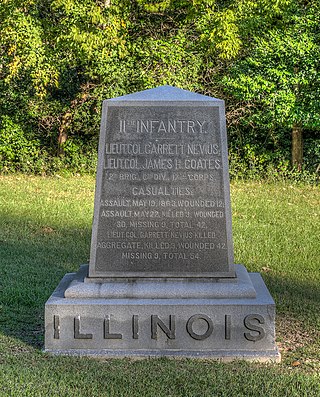Related Research Articles

The Powder River Expedition of 1865 also known as the Powder River War or Powder River Invasion, was a large and far-flung military operation of the United States Army against the Lakota Sioux, Cheyenne, and Arapaho Indians in Montana Territory and Dakota Territory. Although soldiers destroyed one Arapaho village and established Fort Connor to protect gold miners on the Bozeman Trail, the expedition is considered a failure because it failed to defeat or intimidate the Indians.
The 3rd Wisconsin Cavalry Regiment was a volunteer cavalry regiment that served in the Union Army during the American Civil War.

The New York Army National Guard is a component of the New York National Guard and the Army National Guard. Nationwide, the Army National Guard comprises approximately one half of the United States Army's available combat forces and approximately one third of its support organization. National coordination of various state National Guard units are maintained through the National Guard Bureau.

The 2nd Wisconsin Infantry Regiment was an infantry regiment that served in the Union Army during the American Civil War. It spent most of the war as a member of the famous Iron Brigade of the Army of the Potomac. It suffered the largest number of casualties as a percentage of its total enlistment of any Union Army unit in the war.

The 27th Wisconsin Volunteer Infantry Regiment was an infantry regiment that served in the Union Army during the American Civil War. The regiment began organizing in August 1862 but recruiting problems delayed its entry into federal service until March 1863. Predominantly from the Lake Michigan shore counties of the state, the regiment was mainly composed of German immigrants. The 27th Wisconsin played a supporting role in the Siege of Vicksburg and participated in the capture of Little Rock, Arkansas during the year. The regiment served in the Little Rock garrison and saw its first serious combat in the Camden Expedition of 1864, during which it fought in the Battle of Jenkins' Ferry. The regiment was among the Union forces in the Mobile campaign in early 1865, and was involved in the Battle of Spanish Fort. Ending the war in the occupation of Texas, the regiment was mustered out in August before returning to Wisconsin.
The 30th Wisconsin Infantry Regiment was a volunteer infantry regiment that served in the Union Army during the American Civil War.
The 2nd Wisconsin Cavalry Regiment was a volunteer cavalry regiment that served in the Union Army in the western theater of the American Civil War.
Galvanized Yankees was a term from the American Civil War denoting former Confederate prisoners of war who swore allegiance to the United States and joined the Union Army. Approximately 5,600 former Confederate soldiers enlisted in the United States Volunteers, organized into six regiments of infantry between January 1864 and November 1866. Of those, more than 250 had begun their service as Union soldiers, were captured in battle, then enlisted in prison to join a regiment of the Confederate States Army. They surrendered to Union forces in December 1864 and were held by the United States as deserters, but were saved from prosecution by being enlisted in the 5th and 6th U.S. Volunteers. An additional 800 former Confederates served in volunteer regiments raised by the states, forming ten companies. Four of those companies saw combat in the Western Theater against the Confederate Army, two served on the western frontier, and one became an independent company of U.S. Volunteers, serving in Minnesota.
The 1st Iowa Infantry Regiment was an infantry regiment that served in the Union Army during the American Civil War. The regiment's soldiers had enlisted for a period of three months after President Abraham Lincoln called for 75,000 volunteer soldiers in April 1861 after the outbreak of the war. The regiment was officially mustered in on May 14, and John F. Bates was elected as the regiment's commander. Starting out its service at Keokuk, Iowa, the regiment was transferred to Missouri in June, where it joined the forces of Nathaniel Lyon at Boonville. In July, the regiment marched with Lyon from Boonville to Springfield, and it participated in a skirmish at Forsyth on July 22.

The 1st Nebraska Infantry Regiment was an infantry regiment that served in the Union Army during the American Civil War. It was initially organized to protect the Nebraska Territory from Indian attacks, but primarily served in the Western Theater before being reorganized and sent to the frontier.
The 1st Nebraska Cavalry Regiment was a cavalry regiment that served in the Union Army during the American Civil War.
The 7th Iowa Cavalry Regiment was a cavalry regiment that served in the Union Army during the Indian Wars.

The area that eventually became the U.S. state of Montana played little direct role in the American Civil War. The closest the Confederate States Army ever came to the area was New Mexico and eastern Kansas, each over a thousand miles away. There was not even an organized territory using "Montana" until the Montana Territory was created on May 26, 1864, three years after the Battle of Fort Sumter. In 1861, the area was divided between the Dakota Territory and the Washington Territory, and in 1863, it was part of the Idaho Territory.
The 1st Dakota Cavalry was a Union battalion of two companies raised in the Dakota Territory during the American Civil War. They were deployed along the frontier, primarily to protect the settlers during the Dakota War of 1862.

Theodore Washington Brevard Jr. was best known for having served as a military officer in the Confederate States Army. During his tenure with the Confederate army, he eventually reached the rank of Brigadier-General. Brevard was captured by the forces of General George Custer and imprisoned at Johnson's Island. He later died in 1882.
The Adjutant General of Maryland is the head military official of the Maryland National Guard, the Maryland Defense Force, and any other military or paramilitary units that may be maintained by the State of Maryland. The adjutant general is responsible for the military department's budget and maintains all State-owned armories in Maryland.

The 9th Arkansas Infantry Regiment was a regiment of the Confederate States Army during the American Civil War. It served in the Western Theater, seeing action in the Vicksburg, Tennessee and Georgia campaigns. Due to attrition; the 9th Arkansas was consolidated several times with other Arkansas regiments, finally merging in 1865 into the 1st Arkansas Consolidated Mounted Rifles.

The 11th Regiment Illinois Volunteer Infantry was an infantry regiment from Illinois that served in the Union Army during the American Civil War. In April 1861, it was formed as a three-month volunteer unit, and in July 1861 it was reorganized as a three-year unit, in which role it served until the end of the war. Two of its commanding officers were promoted to brigadier general and led major units during the war. In its first major action at Fort Donelson the regiment suffered terrible losses. The 11th Illinois also fought at Shiloh, Riggins Hill, Vicksburg, First Yazoo City, Second Yazoo City, and Fort Blakely. In April 1863, the 109th Illinois Infantry Regiment was disbanded and its enlisted men transferred into the 11th Illinois. The regiment was mustered out of service in July 1865.

The 134th Cavalry Regiment is a cavalry regiment in the Nebraska Army National Guard. By extension, it is a member of the United States Army National Guard, and as a currently federally-recognized unit, also a member of the National Guard of the United States.
References
- ↑ Page 159 to 161 Johnson's History of Nebraska, Harrison Johnson, Henry Gibson (Omaha, Nebraska, 1880)
- ↑ Chapter 32, Ware, The Indian War of 1864
- ↑ Pages 160, 181 Johnson's History of Nebraska
- ↑ Chapter 32, Ware, Eugene, The Indian War of 1864: Being a Fragment of the Early History of Kansas, Nebraska, Colorado and Wyoming", Crane & Company (1911) Eugene Ware was the most junior officer in the 7th Iowa Cavalry when on September 19, 1863 it was deployed to Omaha en route to the Indian Wars.